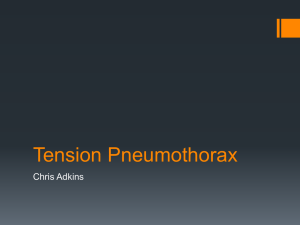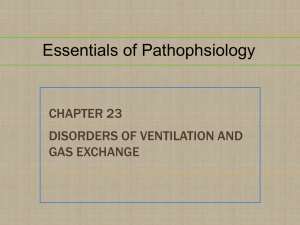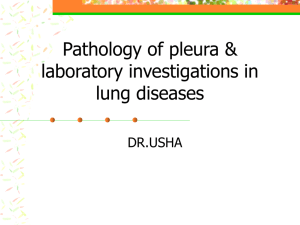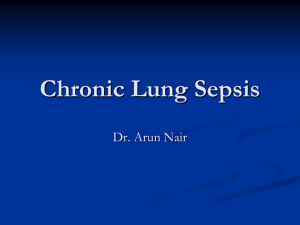Research 2
advertisement
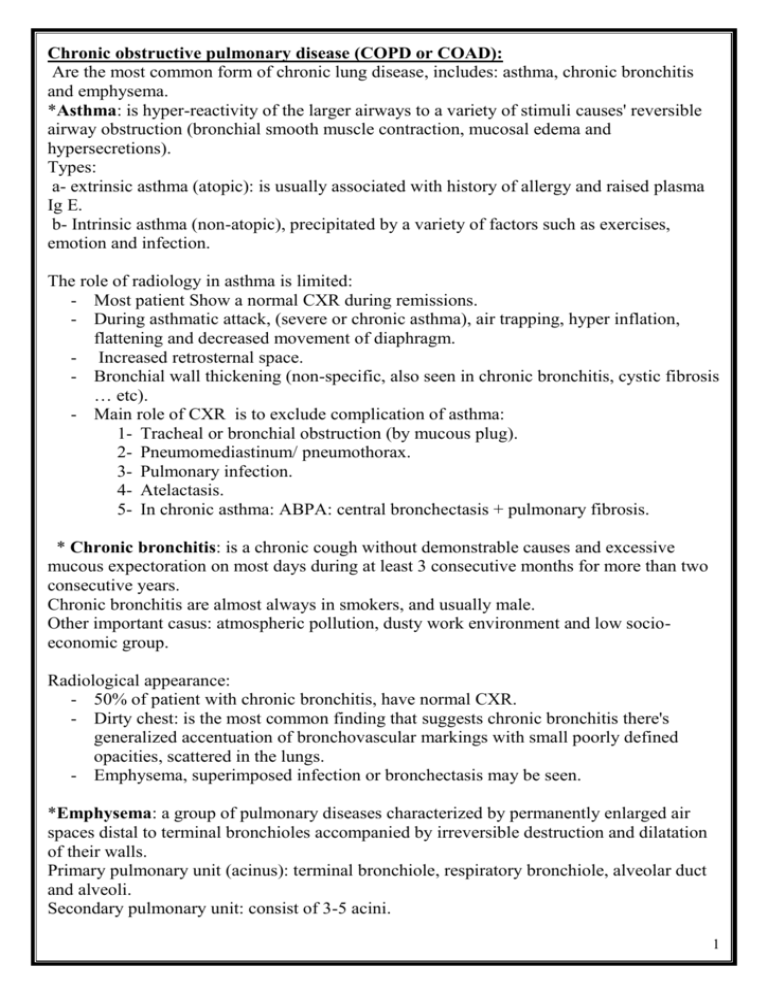
Chronic obstructive pulmonary disease (COPD or COAD): Are the most common form of chronic lung disease, includes: asthma, chronic bronchitis and emphysema. *Asthma: is hyper-reactivity of the larger airways to a variety of stimuli causes' reversible airway obstruction (bronchial smooth muscle contraction, mucosal edema and hypersecretions). Types: a- extrinsic asthma (atopic): is usually associated with history of allergy and raised plasma Ig E. b- Intrinsic asthma (non-atopic), precipitated by a variety of factors such as exercises, emotion and infection. The role of radiology in asthma is limited: - Most patient Show a normal CXR during remissions. - During asthmatic attack, (severe or chronic asthma), air trapping, hyper inflation, flattening and decreased movement of diaphragm. - Increased retrosternal space. - Bronchial wall thickening (non-specific, also seen in chronic bronchitis, cystic fibrosis … etc). - Main role of CXR is to exclude complication of asthma: 1- Tracheal or bronchial obstruction (by mucous plug). 2- Pneumomediastinum/ pneumothorax. 3- Pulmonary infection. 4- Atelactasis. 5- In chronic asthma: ABPA: central bronchectasis + pulmonary fibrosis. * Chronic bronchitis: is a chronic cough without demonstrable causes and excessive mucous expectoration on most days during at least 3 consecutive months for more than two consecutive years. Chronic bronchitis are almost always in smokers, and usually male. Other important casus: atmospheric pollution, dusty work environment and low socioeconomic group. Radiological appearance: - 50% of patient with chronic bronchitis, have normal CXR. - Dirty chest: is the most common finding that suggests chronic bronchitis there's generalized accentuation of bronchovascular markings with small poorly defined opacities, scattered in the lungs. - Emphysema, superimposed infection or bronchectasis may be seen. *Emphysema: a group of pulmonary diseases characterized by permanently enlarged air spaces distal to terminal bronchioles accompanied by irreversible destruction and dilatation of their walls. Primary pulmonary unit (acinus): terminal bronchiole, respiratory bronchiole, alveolar duct and alveoli. Secondary pulmonary unit: consist of 3-5 acini. 1 1- Panacinar (panlobular, non-selective, generalized, diffuse emphysema, pink puffer): Emphysematous changes involving the entire acinus distal to terminal bronchiole, casues: 1- autosomal recessive α1 antitrypsin deficiency. 2- Smoking. The lung may be involved locally or generally, but distributions throughout the lung rarely uniform, although tend to be basal predominance. 2- Centriacinar (centrilobular, blue bloaters): this is selective process characterized by destruction and dilation of the respiratory bronchioles. The alveolar duct, sacs and alveoli are spared until late stage. Upper zones more severely affected than bases, usually seen in smokers in association with chronic bronchitis. 3- Paracicatricial emphysema: dilation and destruction of terminal air spaces adjacent to fibrotic lesions (e.g. TB). 4- Bulla: an emphysematous space > 1cm. 5- Obstructive emphysema: is a misnomer, better termed hyperinflation, since the distal air ways are dilated but not destroyed. Occurs due to one-way valve mechanism in a main bronchi due to a foreign body or Endobronchial tumor, allow air- entry in one way only. So lung distal to obstruction becomes hyperinflated. Radiological appearance: 1- Hyperinflation: flattening of diaphragm, (7th rib anteriorly and 11th rib posteriorly). Increased retrosternal airspace > 3 cm, craniocaudal lung diameter> 29 cm, anterior bowing of sternum (barrel chest), accentuated kyphosis, widely spaced ribs. 2- Vascular abnormalities: decreased vascular markings in abnormally hyperinflated lung area, absence of peripheral pulmonary vessels, increased size of central pulmonary arteries. 3- Hyperlucent lung due to hyperinflation. *Bronchectasis: irreversible dilatation of bronchial tree usually associated with bronchial wall thickening. Clinically presented as recurrent pneumonia and/or haemoptysis. Causes: 1- Post infectious (common): measles, pertusses, chronic granulamatous infections (TB), and allergic bronchopulmonary asperagillosis ABPA. 2- Bronchial obstruction: foreign body, L.A.P., tumor, and aspiration. 3- Congenital disorders (rare): cystic fibrosis, Kartagner syndrome, pulmonary sequestration. Types: cylindrical type, cystic type (or saccular) and varicose type (beaded appearance). Sites: -apical: in cystic fibrosis and TB. -central: in ABPA (especially in asthmatic patient, after 10 years). - Basal in recurrent pulmonary aspiration. Radiological findings: Plain films: tramlines shadows, failure of tapering of bronchi peripherally, or ring shadows (end-on bronchi). Bronchial wall thickening. CT scan: HRCT is the investigation of choice. Bronchi can be seen in outer third of lungs, thickened walls, larger than accompanying arteries, fail to taper peripherally. 2 *Pleural effusion: fluid accumulation in the pleural spaces. This occurs when the rate of production exceeds its rates of re-absorption, causes: 12345- Increased microvascular pressure in lungs (HF). Decreased plasma oncotic pressure (e.g. hypoprotienaemia). Increased microvascular permeability (e.g. pleurisy). Reduced lymphatic drainage from pleural space (e.g. lymphangitis). Passage of peritoneal fluid across defects in diaphragms. Pleural effusions may be transudate, exudates, pus, blood or chyle. Radio logically these produce similar shadow and therefore, indistinguishable. However, there may be clinical data to point to the etiology, or chest film may show other abnormalities, such as evidence of HF or trauma. 1- Transudate: contain less than 3 gm/dl of protein, or the plasma protein/ pleural protein < 0.5 or less than 70% 0f of serum protein level. Usually clear or faintly yellow, watery fluid. Pleural transudate may be called a hydrothorax. They are often bilateral. Commonest cases: - Heart failure, effusions usually accumulate first on right side before becoming bilateral. Other causes: hypoprotienaemia (e.g. nephrotic syndrome, liver cirrhosis and anaemia), constrictive pericarditis, Meigs syndrome and myxoedema. 2- Exudates: contain more than 3 gm/dl of protein, or the plasma protein/ pleural protein > 0.5 or more than 70% 0f of serum protein level. It vary in color from amber, slightly cloudy, (which often clot on standing), to frank pus. A purulent pleural effusion is termed empyaema. The commonest causes of pleural exudates are bacterial pneumonia, pulmonary TB, carcinoma of lung, metastatic malignancy and pulmonary infarction. Less common causes are: Subphrenic infection, connective tissue diseases, (especially SLE and Rh.arthritis), and non bacterial pneumonias: Unusual causes include: post myocardial infarction, acute pancreatitis and primary pleural neoplasm. Radio logical findings: 1- Free fluid: pleural fluid casts a shadow of density of water or soft tissue on chest radiography. In the obscene of pleural adhesions, the position and shape of this shadow will depend upon the amount of fluid, state of underlying lung and patient position. The most dependent recess of the pleura is the posterior costophrenic angle. CXR: > 200 ml fluid required to be visible on PA CXR. > 75 ml fluid required to be visible on lat. CXR. As little as 25 ml fluid detected on lateral decubitus x-ray. US and/or CT scan can detect small amount of pleural effusions. The fluid, as increased in volume, extend upward around posterior > lateral > anterior thoracic wall as the mediastinal portion fixed by pulmonary Lig. + Hilum), forming meniscus – shaped semicircular (concave upper edge), higher laterally than medially obscuring the diaphragmatic shadow. Associated collapse of ipsilateral lung (relaxation type). 3 Massive pleural effusion: - Radiopacity of entire hemithorax. - Displacent of mediastinum to contralateral side. - Severe depression / flattening / inversion of ipsilateral hemidiaphragm. The majority of massive unilateral pleural effusions are malignant (e.g. lymphoma, metastatic disease, primary lung CA). 2- subpulmonic/ subdiaphragmatic/ infrapulmonary pleural effusion: - lateral Displacent of the peak of hemidiaphragm. - Increased distance between the stomach bubble and lung. - Blunted posterior costophrenic angle (on lat. CXR). - CT Scan: - Fluid outside the diaphragm. - Fluid elevating the crus of diaphragm. 3-Lamellar effusion: are shallow collections between the lung surface and the visceral pleura, some types sparing the costophrenic angle: lamellar effusions represent interstitial pulmonary edema. 4-Loculated fluid: the pleural space may be partially obliterated by pleural disease, causing adhesions of the visceral and parietal pleural layers. Encapsulated fluid can be distinguished from free fluid by gravitational methods, but it may be difficult to differentiated from extrapleural opacity, parenchymal lung disease, or mediastinal mass. Radiological findings: - Loculated fluid has little depth (height), but considerable width rather like a biconvex lens. (Best assessed by fluoroscope). - Fluid may become loculated in one or more interlobar fissure, most often seen in heart failure, the opacity may disappear rapidly following treatment of the cause, and hence known as pseudo- or vanishing tumor, they may recur in the subsequent episode of heart failure. *Empyema: refer to pus in the pleural space, with or without gas. Causes: 2- Post infection (Para pneumonic) 60%. 3- Post surgical 20%. 4- Post trauma 20%. Radiographic features: 1- Pleural fluid collection. 2- Thickened pleura. 3- Pleural enhancement. 4- Air-fluid level: may be due to: a- Gas-forming organisms (rare). b- Broncho-pleural fistula (BPF), common. 4 *Pneumothorax: accumulation of air in pleural space. Causes: 1- Spontaneous pneumothorax: A- primary/idiopathic spontaneous pneumothorax (80%): rupture of subpleural blebs in apical region of lung. Common in young patient, 20- 40 years age, M: F = 8:1, especially in tall, asthenic stature, mostly in smokers. - Prognosis; recurrence in 30% on same side, 10% on contralateral side b- Secondary spontaneous pneumothorax (20%): underlying lung diseases: * Air-trapping disease: asthma, emphysema, esinophilic granuloma, cystic fibrosis, tuberous sclerosis. COPD is the most common predisposing disorder of secondary spontaneous pneumothorax. * Pulmonary infection: lung abscess, hydatid disease, staphylococcus aureus (pneumatocele) , pneumocystis carinii pneumonia. * Granulamatous disease: TB, Sarciodosis. * Malignant diseases: primary and secondary lung tumors. * Connective tissue disorder: scleroderma, Rh.arthritis. Marfan syndrome, Ehler-Danlos syndrome. * Pneumoconiosis: silicosis. 2- Traumatic pneumothorax: 1- Penetrating injury (stab wound). 2- Blunt trauma: rib fracture, lung contusion, and bronchial fracture. 3- Iatrogenic: central venous line, PEEP ventilator, tracheostomy, and lung radiation. * Radiographic features: 1- in upright position: radiolucent area devoid of lung vascular markings. - White line of visceral pleura is visible separated from the chest wall and parietal pleura. - Volume loss of underlying lung. 2- Supine position: deep salcus sign, sharply delineated anterior costophrenic angle. 3- Assessment of size of pneumothorax on PA CXR: Average interpleural distance (A+B+C) ÷ 3= cm × 10 convert to percent of pneumothorax. A pneumothorax > 35% usually require treatment by chest tube. * Tension pneumothorax: valve effect during inspiration/ expiraty leads to progressive air accumulation in the pleural cavity, so that the intra-pleural pressure exceeds the atmospheric pressure. Tension pneumothorax is a medical emergency requires immediate pressure deflation (by needle placement or by chest tube). Radiographic features: - Total/ subtotal lung collapse. - Over expanded pleural cavity. - Flattening/ inversion of ipsilateral hemidiaphragm. - Massive displacement of mediastinum to contralateral side. - Collapsed SVC, IVC, right heart border (decreased systemic venous return + decreased cardiac output). - Respiratory embarrassment. 5 *Mediastinum: is situated between the lungs in the centre of thorax. It extends from the thoracic inlet above to the diaphragm below, with the sternum anteriorly and thoracic spines posteriorly and parietal pleura on both sides. Mediastinum is divided into: 1- Superior mediastinum: above imaginary line drawn from T4 vertebra posteriorly to sternal angle anteriorly. 2- Inferior mediastianum: which further divided into: a- Anterior mediastinum: located anterior to pericardium. b- Middle mediastinum: includes the heart and great vessels. c- Posterior mediastinum: posterior to pericardium: involves esophagus, descending aorta, and paraspinal regions. *superior mediastinal mass: 1- Thyroid mass (retrosternal goiter). 2- Enlarged L.N. (Adenopathy). 3- Aneurysms and vascular anomalies. 4- Cystic hygroma. * Anterior mediastinal masses: 1- Thymic tumours: benign and malignant includes: thymoma, thymolipoma, thymic cyst, malignant thymoma, thymic hyperplasia. 2- Germ cell tumours: teratoma, seminoma, chorio CA. 3- Lymphadenopathy: lymphoma 4- Aneurysm and vascular anomalies. 5- Pleuropericlial cyst. 6- Morgagni hernia: usually anterior, right sided. * Middle mediastinal masses: 1- Adenopathy: 90% are malignant from thoracic and extra thoracic malignancies. 2- Aneurysm of aorta or pulmonary artery. 3- Congenital Cysts: Bronchogenic cysts. 4- Tracheal mm. 5- Cardiac tumours. * Posterior mediatinum: 1- Neorogenic tumours: comprises 90% of posterior mediastinal masses. - Neurofibroma and schwanoma 45%. - Sympathetic ganglia tumours: ganglioneuroma, neuroblastoma - Parasympathetic: pheochromocytoma. - Lateral meningocele. 2- Vertebral tumours: - Extramedullary haemopoiesis. - Primary and secondary metastasis. - Infection - Haematoma. 3- Descending aortic aneurysm. 4- Bochdaleck hernias, hiatus hernia, esophageal dilation. 5- Congenital neuroentric cyst usually associated with vertebral anomalies. 6

